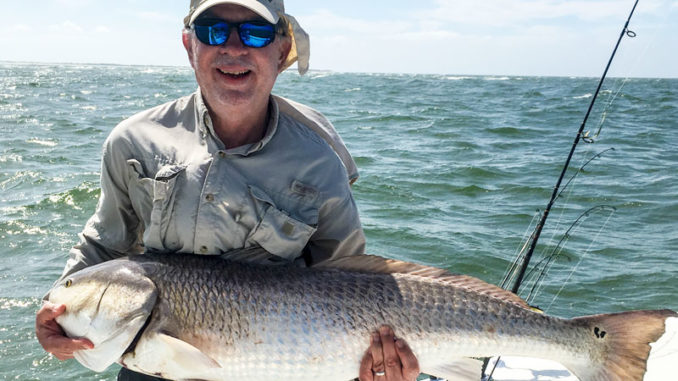
Banner days mark this month for redfish anglers
May marks the return of big red drum in a big way to the nearshore waters of North Carolina’s Hatteras Island after the winter’s offshore respite.
Anglers can climb towers atop their vessels to spot the sea of bronze when massive schools numbering in the hundreds congregate before creeping into casting range or anchoring in sloughs to chunk cut baits when the conditions deteriorate.
“May is when we have our banner days,” said guide Rom Whitaker IV of Hatteras, NC. “The fish are moving closer to the beach as the water warms up and staging around Hatteras, Ocracoke and Drum inlets. They like inlets because the current from the tide helps them feed.”
Whitaker (252-305-5229), who runs Sound Bound Charters, chooses days with light winds and clear water for sight-casting. He cruises the backside of the outer sandbar off the beach in approximately 20 feet of water. He keeps his eyes peeled for a school using the bar to corral baitfish. Patience and a pair of polarized sunglasses with copper or amber lenses are a must-have. Once a school is in his crosshairs, Whitaker goes into stealth-mode.
A slow retrieve works best
“I approach the fish from the upcurrent or upwind side,” he said. “When I’m just outside of casting range, I’ll put an angler on the bow, cut the motor, and drift into them. You want to cast to the far side of the school and work it back through. Give the bait a few seconds to sink, and make a slow retrieve while jigging it. We’ll hook a fish, then try to hook three or four more.”
Whitaker will cast a gold spoon or a bucktail on 30-pound braid with a 4-foot leader of 40- to 60-pound fluorocarbon. He likes a 1 1/8-ounce Johnson Silver Minnow that he rigs with a split ring and swivel to increase action and decrease line twist. The bucktail is typically white, 2 to 3 ounces, with a soft-plastic trailer to enlarge the profile and add action.
When conditions will not allow sight-fishing, Whitaker has a strong backup plan. He anchors in a slough on the ocean side of one of the inlets. Then he fan-casts four or five rods baited with fresh menhaden or mullet. Timing is crucial when anchoring, because the bite will occur during an incoming or outgoing tide, not on slack water. A 4- to 10-ounce egg sinker on a Carolina rig is required to pin the 8/0 circle hook and bait to the bottom. Bait thieves and heavy current will make consistent bait checking important.

